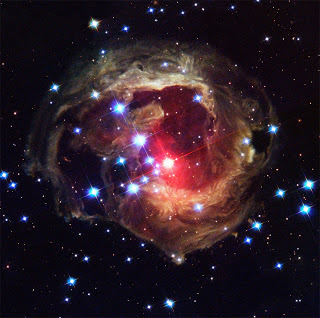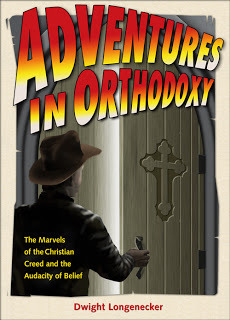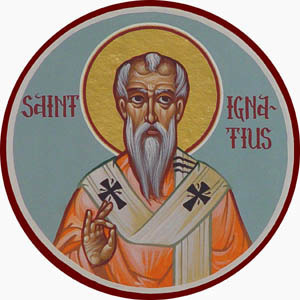Dwight Longenecker's Blog, page 333
October 20, 2011
Evidence and Faith
The problem is not that we do not have enough faith, but that we don't really understand what faith is, and because believers themselves do not understand the concept of faith, and hawk about the wrong ideas of faith it gives ammunition to the doubters, atheists and agnostics.
So, some people believe that having 'faith' is believing something which they secretly think is a load of codswallop. Somehow or other they have to try very hard to suspend their disbelief and 'have faith' in propositions and stories which everybody really knows are just untrue.
Others use have 'faith' in the God of the gaps. That is to say, where scientific and historical evidence stop--faith begins. They're good as long as they can be practical and utilitarian and sensible. Then when all that doesn't work anymore and they're confronted with something for which they do not have an explanation, then 'faith' kicks in.
Then there are the sentimentalists--for them 'faith' is a personal experience. It's a feeling about what is right. It is the moment when they decided to 'trust Jesus' or 'accept Jesus into their heart.' Their faith is validated, they feel, because they have had a memorable emotional experience of repentance and this was combined with 'faith' in Jesus Christ to save them from their sins.
For others 'faith' is an intellectual assent to a certain credal proposition. They believe in a certain set of doctrines and moral precepts, and by 'believe' they mean that they believe them to be true or correct or at least the most practical and positive. This kind of 'faith' is a kind of intellectual agreement.
True faith, however, is something different from all these things, and yet perhaps inclusive of all these things. The man of faith begins with evidence--not lack of evidence. He sees that the world works a certain way. He has particular experiences which give him evidence that he must account for. The religious explanation is the one which he has figured out has the most possibilities of answering the questions that have arisen from the evidence he has gathered and the experiences he has had. He then takes action based on those conclusions, consequently he believes certain things to be true, and on these beliefs and personal experiences he takes action, and begins to live in a certain way. All of this together comprises 'faith'.
The man of faith therefore has certain experiences, believes certain truths, has certain emotions and holds to certain ways of looking at the world, and these things combined enable him to live in a particular way--the way of faith.
Too often religious people have offered only truncated view of faith, and no version of Christianity does this more than Protestantism which offers 'salvation by faith alone.' In this heresy the beliefs and trust and emotions are separated out from the actions which come from faith. The actions don't matter. But 'faith without works is dead.' The faithful actions that result from the step of faith are what make the faith real and make faith a dynamic and living force--rather than a dead and past event.
So, some people believe that having 'faith' is believing something which they secretly think is a load of codswallop. Somehow or other they have to try very hard to suspend their disbelief and 'have faith' in propositions and stories which everybody really knows are just untrue.
Others use have 'faith' in the God of the gaps. That is to say, where scientific and historical evidence stop--faith begins. They're good as long as they can be practical and utilitarian and sensible. Then when all that doesn't work anymore and they're confronted with something for which they do not have an explanation, then 'faith' kicks in.
Then there are the sentimentalists--for them 'faith' is a personal experience. It's a feeling about what is right. It is the moment when they decided to 'trust Jesus' or 'accept Jesus into their heart.' Their faith is validated, they feel, because they have had a memorable emotional experience of repentance and this was combined with 'faith' in Jesus Christ to save them from their sins.
For others 'faith' is an intellectual assent to a certain credal proposition. They believe in a certain set of doctrines and moral precepts, and by 'believe' they mean that they believe them to be true or correct or at least the most practical and positive. This kind of 'faith' is a kind of intellectual agreement.
True faith, however, is something different from all these things, and yet perhaps inclusive of all these things. The man of faith begins with evidence--not lack of evidence. He sees that the world works a certain way. He has particular experiences which give him evidence that he must account for. The religious explanation is the one which he has figured out has the most possibilities of answering the questions that have arisen from the evidence he has gathered and the experiences he has had. He then takes action based on those conclusions, consequently he believes certain things to be true, and on these beliefs and personal experiences he takes action, and begins to live in a certain way. All of this together comprises 'faith'.
The man of faith therefore has certain experiences, believes certain truths, has certain emotions and holds to certain ways of looking at the world, and these things combined enable him to live in a particular way--the way of faith.
Too often religious people have offered only truncated view of faith, and no version of Christianity does this more than Protestantism which offers 'salvation by faith alone.' In this heresy the beliefs and trust and emotions are separated out from the actions which come from faith. The actions don't matter. But 'faith without works is dead.' The faithful actions that result from the step of faith are what make the faith real and make faith a dynamic and living force--rather than a dead and past event.
Published on October 20, 2011 13:08
October 19, 2011
St Isaac Jogues
from New Advent Catholic Encyclopedia...
He was takenprisoner on 3 August, 1642, and after being cruelly tortured was carried to the Indian village ofOssernenon, now Auriesville, on the Mohawk, about forty miles above the present city of Albany. There he remained for thirteen months in slavery, suffering apparently beyond the power of naturalendurance. The Dutch Calvinists at Fort Orange (Albany) made constant efforts to free him, and at last, when he was about to be burnt to death, induced him to take refuge in a sailing vessel which carried him to New Amsterdam (New York). His description of the colony as it was at that time has since been incorporated in the Documentary History of the State. From New York he was sent; in mid-winter, across the ocean on a lugger of only fifty tons burden and after a voyage of two months, landed Christmas morning, 1643, on the coast of Brittany, in a state of absolute destitution. Thence he found his way to the nearest college of the Society. He was received with great honour at the court of the Queen Regent, the mother of Louis XIV, and was allowed by Pope Urban VII the very exceptional privilege of celebrating Mass, which the mutilated condition of his hands had madecanonically impossible; several of his fingers having been eaten or burned off. He was called amartyr of Christ by the pontiff. No similar concession, up to that, is known to have been granted.
In early spring of 1644 he returned to Canada, and in 1646 was sent to negotiate peace with theIroquois. He followed the same route over which he had been carried as a captive. It was on this occasion that he gave the name of Lake of the Blessed Sacrament to the body of water called by theIndians Horicon, now known as Lake George. He reached Ossernenon on 5 June, after a three weeks'journey from the St. Lawrence. He was well received by his former captors and the treaty of peace was made. He started for Quebec on 16 June and arrived there 3 July. He immediately asked to be sent back to the Iroquois as a missionary, but only after much hesitation his superiors acceded to his request. On 27 September he began his third and last journey to the Mohawk. In the interim sickness had broken out in the tribe and a blight had fallen on the crops. This double calamity was ascribed to Jogues whom the Indians always regarded as a sorcerer. They were determined to wreak vengenceon him for the spell he had cast on the place, and warriors were sent out to capture him. The news of this change of sentiment spread rapidly, and though fully aware of the danger Jogues continued on his way to Ossernenon, though all the Hurons and others who were with him fled except Lalande. TheIroquois met him near Lake George, stripped him naked, slashed him with their knives, beat him and then led him to the village. On 18 October, 1646, when entering a cabin he was struck with a tomahawk and afterwards decapitated. The head was fixed on the Palisades and the body thrown into the Mohawk.
Published on October 19, 2011 12:22
Science and the Supernatural

"The supernatural can never explain the physical world we observe." says a friend.
"Of course it can't. It wasn't supposed to--at least in the scientific sense." is my reply.
So my friend has this motorcycle which he really loves to fix up and ride, and I try to explain, "You might as well say that 'love' can never show you how to change the oil on your motorcycle. Science tries to tell us how things work--not why they exist, or what our relationship should be to them. 'Love' might not tell you how to change the oil on your motorcycle, but meditating on love might help you understand why you love that motorcycle, and why you love to ride it on a beautiful Autumn day, and if the motorcycle is a gift from your wife, then love will also show you why that motorcycle has meaning beyond its mechanical genius. Love may not tell you how to change the oil, but it is the one thing that makes your motorcycle more than an ingenious lump of metal.
So with religion and science. The supernatural realm is not some kind of philosophical 'deus ex machina'--a God of the gaps--an answer for natural mysteries when we have no other answer. Instead the supernatural realm is a given within a philosophical view of the cosmos. It is the universal experience of the human race that the unseen realm is 'there'. It's part of reality. Deciding how it interacts with the visible realm and what it has to do with me and my destiny is where the fun begins.
Published on October 19, 2011 04:16
October 18, 2011
Meditation on St Luke
[image error]
This is a theological painting. St Luke is writing his gospel as a result of the act of contemplating the mystery of the incarnation. The Blessed Mother--like the pelican-- feeds the Christ child from her breast as a sign of her unity with her Son who will one day feed the world with the blood and water springing from his side.
St Luke writes the gospel which is his witness of the incarnation. Tradition has it that he was not only the gospel writer, but was also an artist, and that he produced the first icons of the Blessed Virgin. So the artist beholds the artist beholding the image--the icon--of God who is Christ the Lord. The author of the Word of God beholds the Word made flesh. The Mother and child is the mystery of the image of God in Man and woman. The second Eve holds the second Adam and presents him to the world.
The scene is set, not in Palestine in the first century, but in Flanders in the fifteenth century. Why is that? Because the artist--Rogier Van der Weyden-- wants to show that the mysteries he is portraying are timeless. They are alive in his own time. They are alive here and now in this present moment.
Finally, do you see the couple on the bridge in the background? Who are they? Two passers by. Christ the Son of God was incarnate and died for their salvation, but they are intent only on themselves--maybe they are courting-- watching the river of life flow by--oblivious of the mysteries that are above and beyond and behind them--mysteries they can only come to know through the 'sacrament' of the Sacred Scriptures recorded by the Evangelist St Luke.
This is a theological painting. St Luke is writing his gospel as a result of the act of contemplating the mystery of the incarnation. The Blessed Mother--like the pelican-- feeds the Christ child from her breast as a sign of her unity with her Son who will one day feed the world with the blood and water springing from his side.
St Luke writes the gospel which is his witness of the incarnation. Tradition has it that he was not only the gospel writer, but was also an artist, and that he produced the first icons of the Blessed Virgin. So the artist beholds the artist beholding the image--the icon--of God who is Christ the Lord. The author of the Word of God beholds the Word made flesh. The Mother and child is the mystery of the image of God in Man and woman. The second Eve holds the second Adam and presents him to the world.
The scene is set, not in Palestine in the first century, but in Flanders in the fifteenth century. Why is that? Because the artist--Rogier Van der Weyden-- wants to show that the mysteries he is portraying are timeless. They are alive in his own time. They are alive here and now in this present moment.
Finally, do you see the couple on the bridge in the background? Who are they? Two passers by. Christ the Son of God was incarnate and died for their salvation, but they are intent only on themselves--maybe they are courting-- watching the river of life flow by--oblivious of the mysteries that are above and beyond and behind them--mysteries they can only come to know through the 'sacrament' of the Sacred Scriptures recorded by the Evangelist St Luke.
Published on October 18, 2011 03:43
October 17, 2011
Adventures in Orthodoxy

Special book offer: Go here for the details of a special book offer for my book Adventures in Orthodoxy--for just $15.00
Here is what Joseph Pearce said about it:
In this exciting book Longenecker follows in the imaginative footsteps of Chesterton and Lewis. He sees and seizes the thrill of truth with insights of pyrotechnic brilliance. He shows us that orthodoxy is dynamic and thrilling. Hold on tight and enjoy the ride!
If you know this book and like it, do me a favor and recommend it to others by using the 'share' facility at the bottom of the post.
If you would like to purchase the book the best way is to buy it from my website here.
Published on October 17, 2011 14:14
Tolerance, Decadence and Violence

The dictatorship of relativism decrees that tolerance is the only virtue. Because there is no such thing as truth I must tolerate 'your truth' and you must tolerate mine. The problem with this is that tolerance must eventually end in decadence. It ends in decadence because if there is no truth, then there are also no moral standards, and if there are no moral standards, then anything goes, and if anything goes, then decadence is the result.
So we see our society not just drifting into decadence, but suddenly seemingly out of nowhere, we are seeing a full flowering of decadence. The decadence is at every level of society, and is exhibited in disgusting behaviors and beliefs in a multitude of different ways. Sexual immorality is everywhere--children are highly sexualized. Adultery and divorce are rampant. Homosexuality is flagrant. Promiscuity, co-habitation and pre-marital sex are everywhere accepted and open. Furthermore, it is not just among the underclass. Their rampant behaviors are more crude and disgusting, but whether you fornicate in the street drunk on cheap beer or in some high class penthouse with a glass of champagne by your side--it's the same.
Nor is the decadence merely sexual. The materialism and greed and cut throat attitude is everywhere. Again, the underclass may take to the streets rioting and smashing and grabbing. They are only exhibiting in their way what they have seen the upper classes do--it's just that the upper classes have done so on a much more massive scale by paying lobbyists to change the banking rules so they can sell shoddy financial products to rip people off and make millions. The underclass burn buildings and loot and burn as we saw in London this summer. The upperclass destroy an economy to take salaries of several million and bonuses paid for by the government bail outs.
Are we surprised that violence is the result? Why should we? The tolerance that results from relativism leads to decadence and decadence always leads to violence. Why violence? Because the decadent are never satisfied. Their decadent behavior leads to self loathing, envy and hatred of others. They become possessed with a seething hatred and project it on to others. Why did the mobs in Rome break into a church and desecrate the crucifix and the image of the Blessed Mother? Because the violent mobs will hate most of all those who never bought into their demonic creed of relativism and tolerance in the first place, and who (even silently by their purity) criticized the decadence that resulted from it.
I hate to be a pessimist, but unless there is an outpouring of the Holy Spirit to convert souls we should be prepared for an ever growing hatred of the Catholic Church. The tolerance time is over. The decadence stage is in full swing. Get ready for the violence.
On this day when we celebrate the feast of dear old St Ignatius of Antioch witness his example. His death was a symbol of everything I am talking about. The violent came to take him away and the gentle old man was torn to pieces by hungry lions. The lions are out there now, prowling about--seeking whom they may devour.
Published on October 17, 2011 13:58
St Ignatius of Antioch

Written on his way to Rome to be martyred by being thrown to the lions:
I am writing to all the churches to let it be known that I will gladly die for God if only you do not stand in my way. I plead with you: show me no untimely kindness. Let me be food for the wild beasts, for they are my way to God. I am God's wheat and shall be ground by their teeth so that I may become Christ's pure bread. Pray to Christ for me that the animals will be the means of making me a sacrificial victim for God.
No earthly pleasures, no kingdoms of this world can benefit me in any way. I prefer death in Christ Jesus to power over the farthest limits of the earth. He who died in place of us is the one object of my quest. He who rose for our sakes is my one desire.
The time for my birth is close at hand. Forgive me, my brothers. Do not stand in the way of my birth to real life; do not wish me stillborn. My desire is to belong to God. Do not, then, hand me back to the world. Do not try to tempt me with material things. Let me attain pure light. Only on my arrival there can I be fully a human being. Give me the privilege of imitating the passion of my God. If you have him in your heart, you will understand what I wish. You will sympathise with me because you will know what urges me on.
Published on October 17, 2011 10:49
Swan Silvertones

After the previous post someone asked if I was punishing the readers again, well I actually like 'Love Lifted Me' by the Swan Silvertones, so allow me to explain why I like that, but I dislike 'Jesus is Your Friend' and 'I Walked Through the Garden Alone' and Anglicans dressed up in trendy vestments.
It is always difficult for to explain one's taste, but I think I would sum up mine by saying I have a taste for the authentic. The genuine appeals to me while the artificial, hypocritical, sentimental and saccharine does not.
There is an authenticity to the Swan Silvertones. They are themselves. Their music is unpretentious and un-self conscious. They sing from the heart, and they sing well. They are not trying to be anyone else, and their music is not all tarted up with technological fakery and stagey legerdemain. Their ingenuity and musicianship is totally genuine and like all great artists, they blended styles and talent into a new synthesis--creating something new out of the old.
Furthermore, if you like the Swan Silvertones you like them exactly for who they are. Too often our 'taste' is developed because someone classy or educated or rich told us we should like something. So we try to like it long enough and then we think we do, when in fact we don't really like it and are only pretending in order to think ourselves classier or more educated than we really are. Even worse, our 'taste' is often determined by a fear of not liking what everyone else likes. We don't want to be thought unusual. We want to fit in with the 'tasteful' set. Worst of all, our 'taste' is determined by the cult of celebrity--so we 'like' something because it's famous. Thus all the tourists who troop through the Louvre missing everything on the way in order to stand in front of the Mona Lisa for two minutes before yawning and getting back on the bus.
So that's the first explanation of my taste in things. The second is that the music of the Swan Silvertones is not immediately attractive to me. I don't want to pretend to like something I don't like, but I do want to try new things. That's an adventure. If I end up not liking something new, (or have good reasons for not trying something new--like I really do not want to try the new jalapeno cheeseburger on a pizza biscuit at Jack in the Box) then I will either figure out why I don't like the new thing or maybe I will develop a taste for it, and my life is richer.
So I like Swan Silvertones because they surprised me with something I hadn't experienced before--something authentic and cool and heart felt. I made an effort and learned to like something worthwhile. I have had the same experience with curry, opera, Bourbon and the Catholic faith.
Finally, I like Swan Silvertones singing Love Lifted Me because it is heartfelt, but not sentimental. The words are simple, homely and sweet words of a devotional hymn that focus on the love of Christ--not on me and my walk through the garden or along the beach.
That doesn't mean you have to like the Swan Silvertones.
But you could try...
Published on October 17, 2011 06:36
Dwight Longenecker's Blog
- Dwight Longenecker's profile
- 80 followers
Dwight Longenecker isn't a Goodreads Author
(yet),
but they
do have a blog,
so here are some recent posts imported from
their feed.



